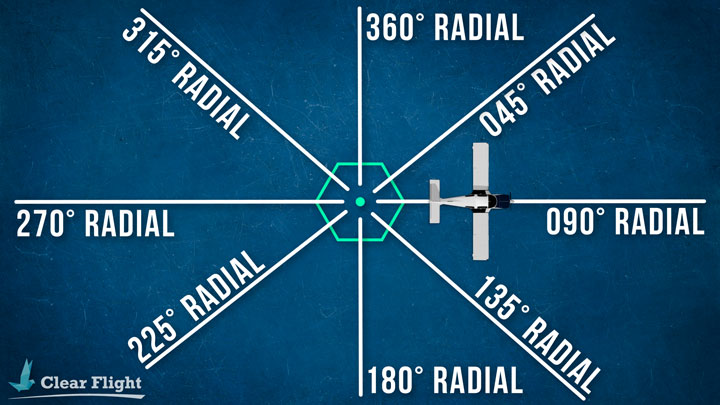The VOR Ground Station
The Very High Frequency Omni-Directional Radio Range (VOR) is a ground based radio navigation aid that has an infinite number of radials that radiate outwards. In practice, we use 360 radials in relation to magnetic north.
The aircraft’s VOR receiver can determine which radial the aircraft is on and whether flying that track would take you towards (TO) or away from (FROM) the VOR.
In this example, the VOR receiver will know the aircraft is on the 090° radial and that flying a track of 090° would take the aircraft away FROM the VOR
The radials only radiate outwards, so the aircraft’s heading or track may be completely different from the radial it is on. In the example below, the aircraft is flying towards the VOR on the 180° radial but it is flying a track of 360° (QDM=360°).
The Aircraft’s VOR Receiver
The pilot twists the Omni-Bearing Selector (OBS) knob on the Course Deviation Indicator (CDI) to select a radial from or bearing to the VOR. The needle will be centred when the aircraft is on that radial.
In this example, the pilot has selected the 090° (east) radial and flying a track of 090° will take the pilot away from the VOR (shown by the FROM indication). The needle (vertical bar) is centered when the aircraft is on the selected radial.
The centre circle can be thought of as the aircraft and the needle as the chosen radial. If the aircraft moves away from the chosen radial, the needle will indicate where the radial is relative to the aircraft. For example:
The VOR receiver works independently of the aircraft heading. The indications on the cockpit instrument will only ‘make sense’ if your heading and the OBS selection are roughly the same.
In other words, the instrument is designed to give correct indications to a pilot who is flying along the selected radial from or bearing to the VOR.
TO, FROM and the Warning Flag
The TO and FROM indications tell the pilot whether their OBS selection will take the pilot to the VOR or away from it.
When tracking along a radial inbound to a VOR, the TO indication changes to FROM as you fly overhead. During this change, a brief period of inaccuracy exists as you fly overhead and a warning flag may appear on the cockpit instrument.
The warning flag indicates inadequate signal or loss of power and the instrument cannot be used when the warning flag is showing.
CDI Dots
Each dot on the CDI shows 2° of deviation from the chosen radial, up to the last dot which shows 10° or more.
In the below example, the needle is telling the pilot they are 5° to the right of their chosen radial (i.e. the chosen radial is 270°, but they are currently on radial 275°). The instrument is telling the pilot to ‘fly left’.
VOR Limitations
Check out this video from Captain Joe on the VOR:







